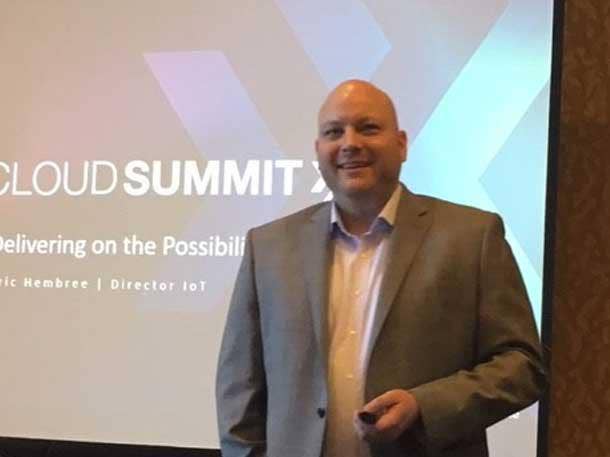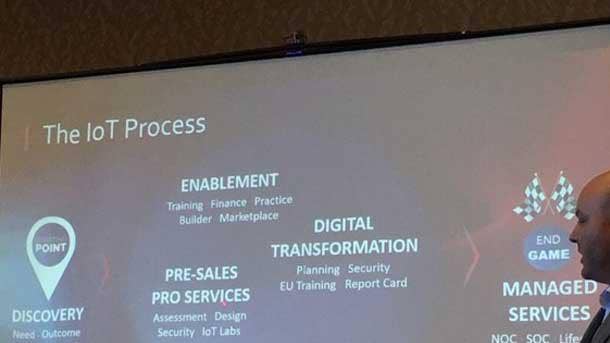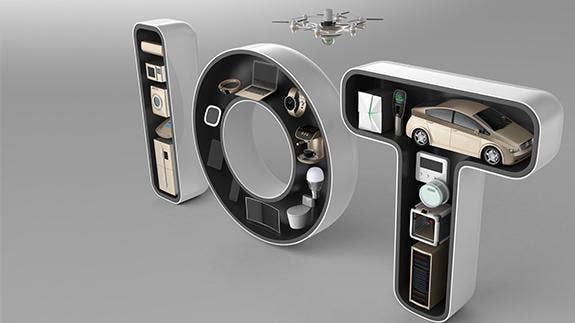Ingram Micro Unveils IoT Marketplace, Outlines Six Steps To Solution Provider Success

Making An IoT Channel Play
Ingram Micro this week launched its IoT Marketplace as a way to help solution providers more easily get started with the Internet of Things or quickly build upon any experience they already have.
Eric Hembree, director of IoT at Ingram Micro, told solution providers at the Ingram Micro Cloud Summit X conference that the IoT Marketplace gives them a starting place in the business with a variety of kits, which include sensors, gateways and other components for building complete IoT solutions.
With the kits, Ingram Micro has one simple message, Hembree said. "Stop making IoT so hard," he said.
Ingram Micro is looking to provide the resources to help solution providers succeed with IoT, Hembree said. "We want to simplify it," he said. "We want to standardize the process."
Ingram Micro introduced a couple of pre-packaged kits that aim to help solution providers, regardless of their IoT experience, successfully implement it.

Simplifying The Process
To help solution providers hit the ground running or quickly expand on prior IoT experience, Ingram Micro has introduced IoT kits that include sensors, gateways and other components. The sensors are optimized for the gateways to ensure data flows correctly, Hembree said.
Hembree declined to call them "bundles," as that term suggests bringing products together for pricing reasons only. "We have solutions and kits," he said. "The solutions can be priced with no up-front costs, but factored into the recurring revenue. Recurring revenue is the longtail business."
The kits target solution providers at different levels. One set of kits, aimed at solution providers just entering the market, contains about 90 percent of a complete solution, including sensors optimized for the gateways, leaving the final configuration up to the solution provider, Hembree said.
The other kit, for solution providers with some IoT experience, is about 60 percent of the complete solution and lets them provide more of their own value-add, he said.
Security for the solutions can be added via vendors such as Symantec, or solution providers can offer their own security solutions, Hembree said. Ingram Micro is also partnering with a third-party developer of a security chip that can be installed in many of the devices.
"The security portion is paramount," he said. "We want partners to have peace of mind with the solution."
Here are Hembree’s six steps for help solution providers succeed in IoT.

Discovery
This part of the process is focused on discovering customers' actual needs, Hembree said. "It's so easy to go down the rabbit hole and get lost in the minutiae," Hembree said.
It's important to understand what customers need and build just to those requirements, he said. "You don't need to add everything right out of the gate," he said. "Most of the time, they just want the data from the devices."
Ingram Micro is helping by providing what Hembree called an Outcome Solving X Matrix to help solution providers clearly understand customers' requirements.

Enablement
Solution providers need to get trained and understand how to best approach IoT, Hembree said.
Ingram Micro offers an IoT University with training and a three-day certification track, which also includes solution providers actually standing up an IoT platform, he said.
The distributor also offers a financing program, he said. "Just ask," he said. "Chances are, we might just say yes. … At the end of the day, we want to make sure we reach a ‘yes’ that works for you, your customer, and Ingram Micro."
Solution providers can also take advantage of Ingram Micro's practice builder program, which helps them understand their gaps and see what's needed to fill them.
The Ingram Micro IoT Marketplace makes it easy to find the right products by vertical or by vendor, he said.

Presales Professional Services
Ingram Micro is providing solution providers with a number of IoT-related services, Hembree said, including:
* Assessments of networks, security and the other parts partners need to build a solution. This includes site assessments, whether it’s the data center or the factory floor.
* Design of the solution
* IoT Labs where customers can come in to see how IoT will work for them.

Digital Transformation
The digital transformation is not focused on the solution provider, but on the customer, Hembree said. It is important to train end customers, he said. "If they can't fully understand and embrace the concept, you're dead in the water," he said.
Digital transformation is also important from a security perspective, given that security can be done via a chip in the devices, as well as via a solution provider’s own or third-party Security Operations Center as a service, he said.

Implementation
Solution providers will have to deploy the solution, which can be done with Ingram Micro's help, or integrate IoT into existing solutions such as ERP, where third-party systems integrators can be brought in, Hembree said.
Solution providers will also have to bring in new dashboards to handle the raw data that streams from the sensors, he said.
IoT is not really that new, he said. "But things that were previously siloed can now be integrated," he said.

Managed Services
The real money around IoT will come from services around the Network Operations Center, Security Operations Center and life cycle, Hembree said.
For instance, he said, a Network Operations Center service is critical for managing sensors or knowing if there are any failures, he said. Ingram Micro can bring in third-party providers to help with such services for solution providers without their own services, he said.